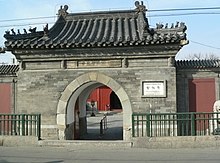Zhihua Si Temple
| Zhihua Temple | |
|---|---|

Main entrance to the Zhihua Si Temple
|
|
| Basic information | |
| Location | Beijing |
| Geographic coordinates | 39°54′58″N 116°25′33″E / 39.916156°N 116.425884°ECoordinates: 39°54′58″N 116°25′33″E / 39.916156°N 116.425884°E |
| Affiliation | Buddhism |
| Country | China |
The Zhihua Temple (; pinyin: Zhìhuà Sì; lit. "Temple of Wisdom Attained") is a Ming dynasty-era Buddhist temple in Beijing, China. It is located in the Lumicang (禄米仓) hutong, in the Chaoyangmen area of Dongcheng District, within the Second Ring Road to the north of Jinbaojie Street, west of the Yabaolu area. The temple was built in 1443 at the order of Wang Zhen, a powerful eunuch in the Rites Supervising Office of the court of the Zhengtong Emperor (also known as Emperor Yingzong; reigned 1436-1449 and 1457-1464).
The temple, surrounding buildings, and grounds comprise approximately 2 hectares (4.9 acres). It is one of the most important original building complexes from the Ming dynasty period in the Old City area, and one of the only wooden structures and groups of buildings from the Ming dynasty to remain intact in Beijing. It is also striking for its extensive use of black roof tiles. The Beijing Cultural Exchange Museum, established in November 1992, is located in the temple compound; its principal aim is "as a centre for developing cultural exchange and for developing the study of cultural relics and museums."
At the temple, a group of musicians regularly performs centuries-old ritual music which has been handed down over 27 generations. The six-member group is led by the octogenarian Buddhist monk Zhang Benxing (张本兴, born c. 1922), the only surviving member of the 26th generation of musicians, and the last person to have learned the music in the traditional manner. In addition to singing voices, the instruments used include guanzi (oboe), dizi (bamboo flute), sheng (mouth organ), yunluo (a set of ten small tuned gongs mounted vertically in a frame), and percussion including drums and cymbals.
The Zhihua Temple became a nationally preserved cultural and historic relic in 1961. In 2005 the Chinese government undertook a renovation of the temple (which is now complete) in preparation for the numerous international visitors expected at the time of the 2008 Summer Olympics.
...
Wikipedia
